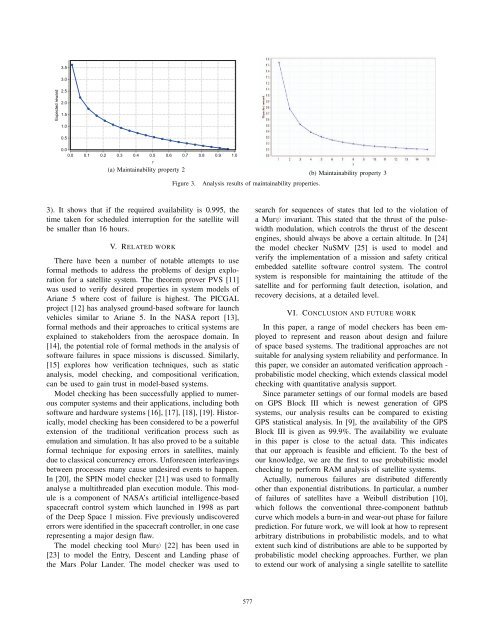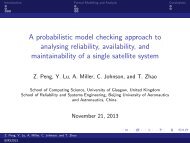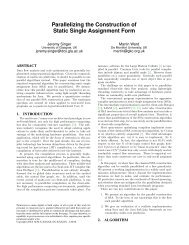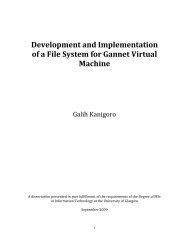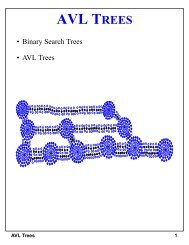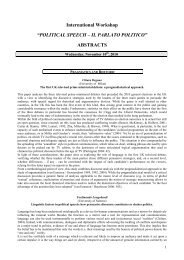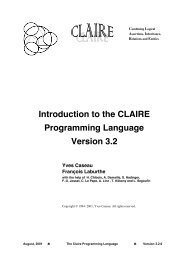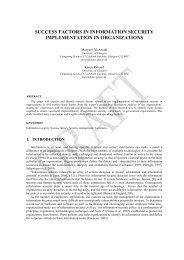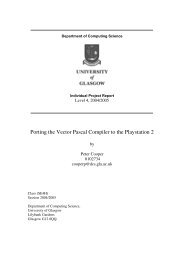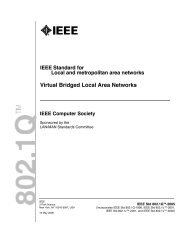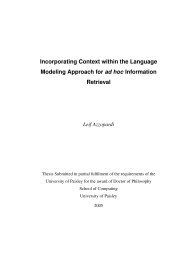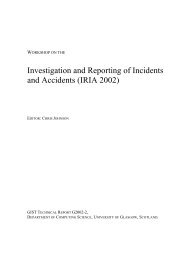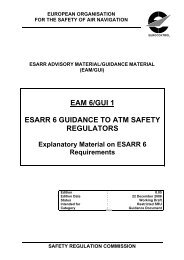A Probabilistic Model Checking Approach to Analysing Reliability ...
A Probabilistic Model Checking Approach to Analysing Reliability ...
A Probabilistic Model Checking Approach to Analysing Reliability ...
Create successful ePaper yourself
Turn your PDF publications into a flip-book with our unique Google optimized e-Paper software.
(a) Maintainability property 2<br />
Figure 3.<br />
Analysis results of maintainability properties.<br />
(b) Maintainability property 3<br />
3). It shows that if the required availability is 0.995, the<br />
time taken for scheduled interruption for the satellite will<br />
be smaller than 16 hours.<br />
V. RELATED WORK<br />
There have been a number of notable attempts <strong>to</strong> use<br />
formal methods <strong>to</strong> address the problems of design exploration<br />
for a satellite system. The theorem prover PVS [11]<br />
was used <strong>to</strong> verify desired properties in system models of<br />
Ariane 5 where cost of failure is highest. The PICGAL<br />
project [12] has analysed ground-based software for launch<br />
vehicles similar <strong>to</strong> Ariane 5. In the NASA report [13],<br />
formal methods and their approaches <strong>to</strong> critical systems are<br />
explained <strong>to</strong> stakeholders from the aerospace domain. In<br />
[14], the potential role of formal methods in the analysis of<br />
software failures in space missions is discussed. Similarly,<br />
[15] explores how verification techniques, such as static<br />
analysis, model checking, and compositional verification,<br />
can be used <strong>to</strong> gain trust in model-based systems.<br />
<strong>Model</strong> checking has been successfully applied <strong>to</strong> numerous<br />
computer systems and their applications, including both<br />
software and hardware systems [16], [17], [18], [19]. His<strong>to</strong>rically,<br />
model checking has been considered <strong>to</strong> be a powerful<br />
extension of the traditional verification process such as<br />
emulation and simulation. It has also proved <strong>to</strong> be a suitable<br />
formal technique for exposing errors in satellites, mainly<br />
due <strong>to</strong> classical concurrency errors. Unforeseen interleavings<br />
between processes many cause undesired events <strong>to</strong> happen.<br />
In [20], the SPIN model checker [21] was used <strong>to</strong> formally<br />
analyse a multithreaded plan execution module. This module<br />
is a component of NASA’s artificial intelligence-based<br />
spacecraft control system which launched in 1998 as part<br />
of the Deep Space 1 mission. Five previously undiscovered<br />
errors were identified in the spacecraft controller, in one case<br />
representing a major design flaw.<br />
The model checking <strong>to</strong>ol Murψ [22] has been used in<br />
[23] <strong>to</strong> model the Entry, Descent and Landing phase of<br />
the Mars Polar Lander. The model checker was used <strong>to</strong><br />
search for sequences of states that led <strong>to</strong> the violation of<br />
a Murψ invariant. This stated that the thrust of the pulsewidth<br />
modulation, which controls the thrust of the descent<br />
engines, should always be above a certain altitude. In [24]<br />
the model checker NuSMV [25] is used <strong>to</strong> model and<br />
verify the implementation of a mission and safety critical<br />
embedded satellite software control system. The control<br />
system is responsible for maintaining the attitude of the<br />
satellite and for performing fault detection, isolation, and<br />
recovery decisions, at a detailed level.<br />
VI. CONCLUSION AND FUTURE WORK<br />
In this paper, a range of model checkers has been employed<br />
<strong>to</strong> represent and reason about design and failure<br />
of space based systems. The traditional approaches are not<br />
suitable for analysing system reliability and performance. In<br />
this paper, we consider an au<strong>to</strong>mated verification approach -<br />
probabilistic model checking, which extends classical model<br />
checking with quantitative analysis support.<br />
Since parameter settings of our formal models are based<br />
on GPS Block III which is newest generation of GPS<br />
systems, our analysis results can be compared <strong>to</strong> existing<br />
GPS statistical analysis. In [9], the availability of the GPS<br />
Block III is given as 99.9%. The availability we evaluate<br />
in this paper is close <strong>to</strong> the actual data. This indicates<br />
that our approach is feasible and efficient. To the best of<br />
our knowledge, we are the first <strong>to</strong> use probabilistic model<br />
checking <strong>to</strong> perform RAM analysis of satellite systems.<br />
Actually, numerous failures are distributed differently<br />
other than exponential distributions. In particular, a number<br />
of failures of satellites have a Weibull distribution [10],<br />
which follows the conventional three-component bathtub<br />
curve which models a burn-in and wear-out phase for failure<br />
prediction. For future work, we will look at how <strong>to</strong> represent<br />
arbitrary distributions in probabilistic models, and <strong>to</strong> what<br />
extent such kind of distributions are able <strong>to</strong> be supported by<br />
probabilistic model checking approaches. Further, we plan<br />
<strong>to</strong> extend our work of analysing a single satellite <strong>to</strong> satellite<br />
577


